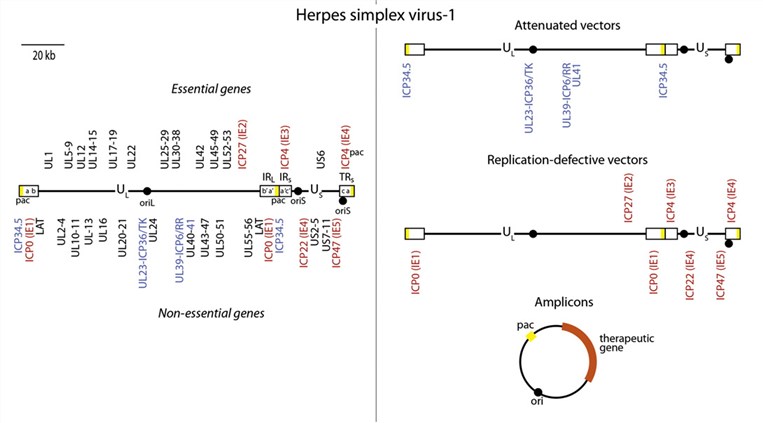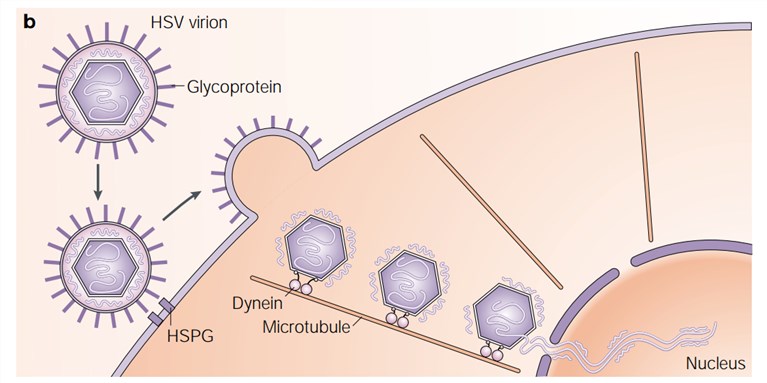Vectors Based on the Herpes Simplex Virus (HSV)
Vectors derived from Herpes simplex virus vectors (HSV) have come to dominate the field of gene delivery for the treatment of neurological disorders.
Herpes Simplex Virus (HSV)
HSV is a linear double-stranded DNA virus with a genome of approximately 150 kb length, encoding 70 to 80 viral proteins, which determines the numerous functions and the large packaging capacity of this virus for insertion of foreign genes of 30 to 50 kb. The virion of HSV is a large (~186 nm) regular icosahedral structure in which the linear dsDNA genome is the viral core. Among all the HSV, the human simplex viruses type 1 and 2 are the most characteristics and therefore are used as viral vectors under extensive investigation of gene delivery.
In addition to encoding proteins for viral structure and replication, the HSV genome is also responsible for proteins involved in cell attachment and other functions. Many of them are nonessential for viral replication and thus, can be removed to permit the insertion of large exogenous coding regions into the viral genome, but do not influence the genome replication or packaging of the virus. Furthermore, the deletion of several nonessential immediate-early (IE) genes coding the viral proteins in the infection, such as ICP0, ICP4, ICP22, and ICP47, results in an entirely nontoxic HSV vector, which can persist for an extended time in host cells.
 Figure 1. The HSV genome and the corresponding vector. (Giacca, 2012)
Figure 1. The HSV genome and the corresponding vector. (Giacca, 2012)
Different Types of HSV-based Vectors
Three different types of vectors derived from HSV have been considered: attenuated vectors, replication-defective vectors, and amplicon vectors. Two primary technologies are followed for the generation of HSV-based vectors, which either use directly replacing the HSV gene by the therapeutic transgene to establish the recombinant HSV-vector or insertion of the foreign DNA into an amplicon plasmid vector.
- HSV-based Attenuated Vectors
To improve HSV vectors for gene therapy of brain tumors and to reduce neurotoxicity, attenuated (replication-conditional) vectors have been developed by carrying mutations in the viral genes, which is essential for replication in nondividing cells but not for replication in dividing cells. Therefore, attenuated vectors are still capable of replicating, which is toxic to infected cells and make them desirable for targeting proliferating cells for killing.
- HSV-based Replication-defective Vectors
More extensive removal of HSV genes leads to the creation of replication-defective vectors, which cannot replicate autonomously and require a helper cell line with complementing function for transduction. This reduces the vector toxicity and the host immune response to viral gene; as a result, these vectors can deliver and facilitate the long-expression of a transgene in vivo.
- HSV-based Amplicon Vectors
Another significant advancement in the design of HSV vectors is based on the identification of the minimal cis-acting elements for virus replication. Amplicon vectors contain only the HSV origin of replication, the HSV packaging signal, and have a packaging capacity of ~150 kb gene of interest. These vectors have several advantages, including the lack of viral genes that might cause cytotoxicity, the maximal transgene coding capacity, the ability to package of head-to-tail concatemers vector, and persistence of transgene expression for months.
 Figure 2. Schematic of HSV entry into cells. (Davidson, 2003)
Figure 2. Schematic of HSV entry into cells. (Davidson, 2003)
Advantages of HSV-based Vectors
- Larger insertion capacity up to 150 kb for foreign DNA
- Natural tropism toward neuronal cells
- High viral titers of up to 10¹² PFU/ml
- Infection of various cell types
- Long-term expression, low toxicity (mutants)
- Relatively stable and high level of safety
Applications of HSV-based Vectors
HSV vectors have a broad host range to be able to infect nondividing cells, and the capacity to carry large regions of exogenous DNA. Due to the naturally neurotrophic features of HSV, it has an attractive potential suited for the treatment applications directed at neurological diseases such as Parkinson's disease and Alzheimer's. In addition, HSV possesses the ability to infect efficiently a wide range of cell and tissue types, such as muscle, heart and liver, which also makes it an excellent vector for treating non-neurological diseases. In summary, herpesvirus-derived vectors hold promise as tools for gene delivery to the CNS, but also need further progress and scalable methods.
References
- Giacca, M.; Zacchigna, S. (2012). Virus-mediated gene delivery for human gene therapy. Journal of controlled release. 161(2): 377-388.
- Davidson, B.L.; Breakefield, X.O. (2003). Viral vectors for gene delivery to the nervous system. Nature Reviews Neuroscience. 4(5): 353.
